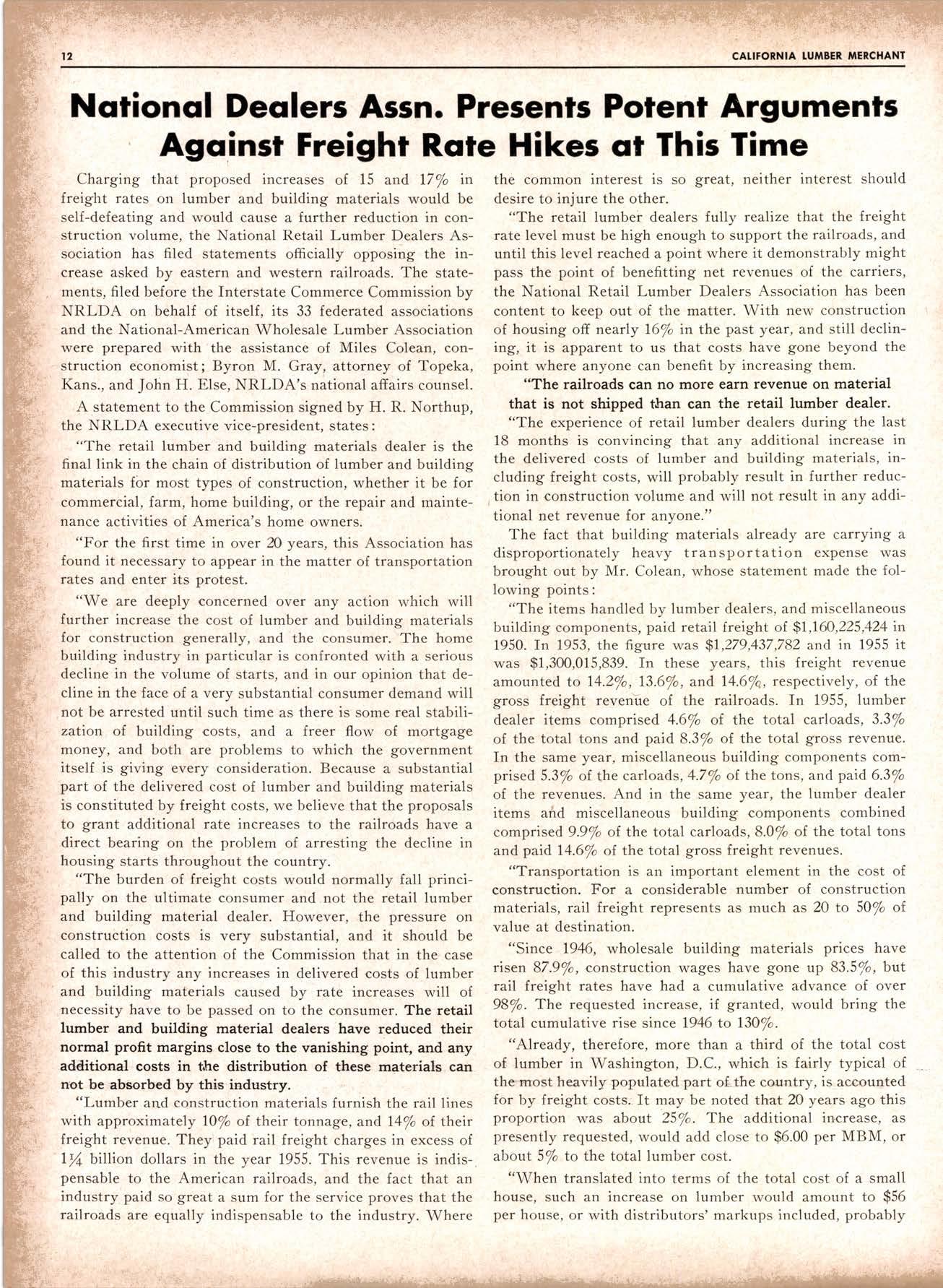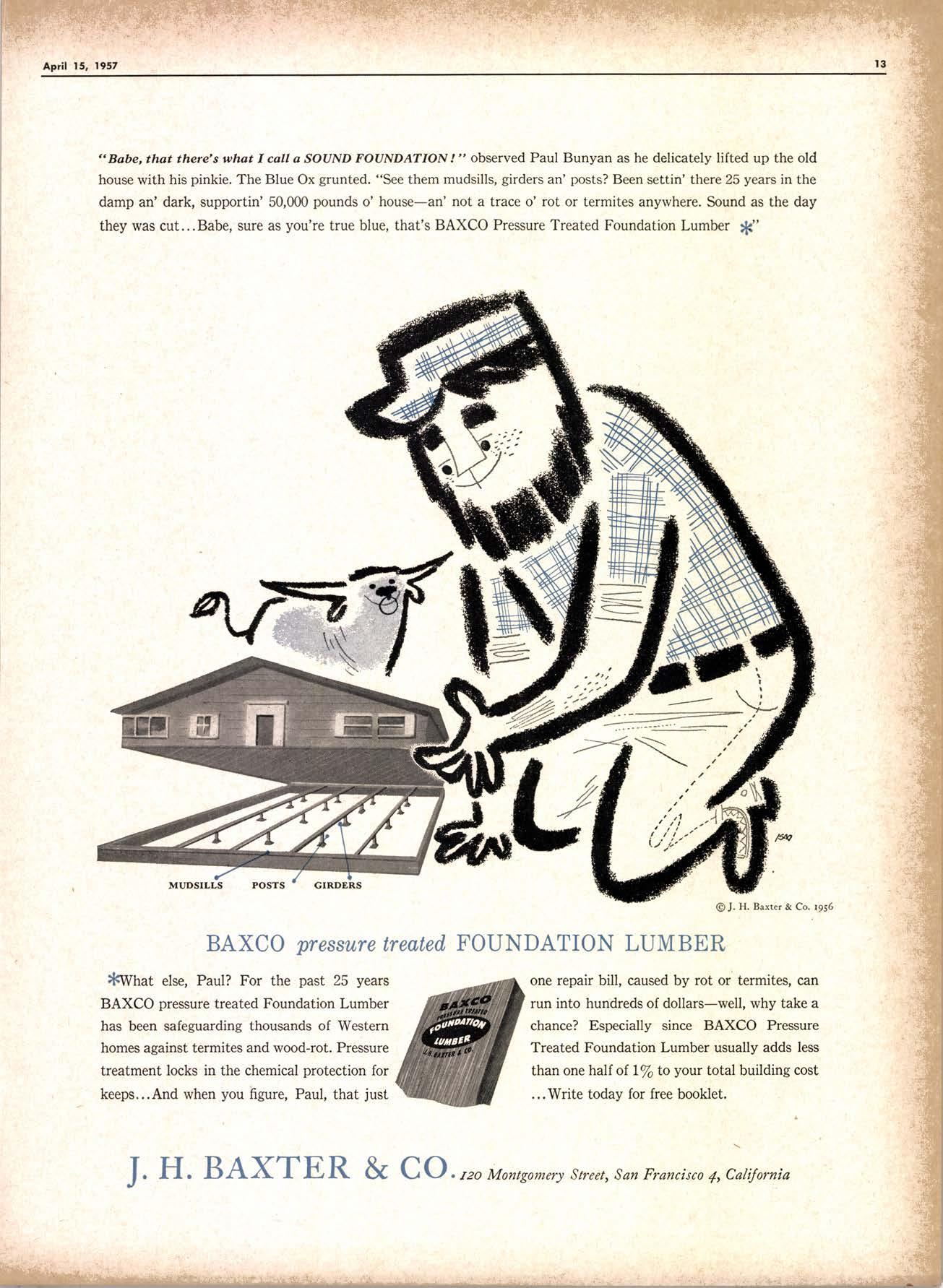
4 minute read
Ncrtionql Deqlers Assh. Presenls Potenr Argumenls Agoinst Freighr Rote Hikes or This Time
Charging that proposed increases of 15 and, l7/o in freight rates on lumber and building materials would be self-defeating and would cause a further reduction in construction volume, the National Retail Lumber Dealers Association has filed statements officially opposing the increase asked by eastern and western railroads. The statements, filed before the Interstate Commerce Commission by NRLDA on behalf of itself, its 33 federated associations and the National-American Wholesale Lumber Association were prepared with the assistance of Miles Colean, construction economist; Byron M. Gray, attorney of Topeka, Kans., and John H. Else, NRLDA's national affairs counsel.
A statement to the Cornmission signed by H. R. Northup, the NRLDA executive vice-president, states:
"The retail lumber and building materials dealer is the final link in the chain of distribution of lumber and building materials fbr most types of construction, whether it be for commercial , farm, home building, or the repair and maintenance activities of America's home owners.
"For the first time in over 2O years, this Association has found it necessary to appear in the matter of transportation rates and enter its protest.
"We are deeply concerned over any action which will further increase the cost of lumber and building materials for construction generally, and the consumer. The home building industry in particular is confronted with a serious decline in the volume of starts, and in our opinion that decline in the face of a very substantial consumer demand will not be arrested until such time as there is some real stabilization of building costs, and a freer flow of mortgage money, and both are problems to which the government itself is giving every consideration. Because a substantial part of the delivered cost of lumber and building materials is constituted by freight costs, we believe that the proposals to grant additional rate increases to the railroads have a direct bearing on the problem of arresting the decline in housing starts throughout the country.
"The burden of freight costs would normally fall principally on the ultimate consumer and not the retail lumber and building material dealer. However, the pressure on construction costs is very substantial, and it should be called to the attention of the Commission that in the case of this industry any increases in delivered costs of lumber and building materials caused by rate increases will of necessity have to be passed on to the consumer. The retail lumber and building material dealers have reduced their normal profit margins close to the vanishing point, and any additional costs in the distribution of these materials can not be:absorbed by tltis industry.
"Lumber and construction materials furnish the rail lines with approximately lo/o of their tonnage, and I4/o of their freight revenue. They paid rail freight charges in excess of lfu billion dollars in the year 1955. This revenue is indispensable to the American railroads, and the fact that an industry paid so great a sum for the service proves that the railroads are equally indispensable to the industry. Where the common interest is so great, neither interest should desire to injure the other.
"The retail lumbei dealers fully realize that the freight rate level must be high enough to support the railroads, and until this level reached a point where it demonstrably might pass the point of benefitting net revenues of the carriers, the National Retail Lumber Dealers Association has been content to keep out of the matter. With new construction of housing off nearly 16/o in the past year, and still declining, it is apparent to us that costs have gone beyond the point where anyone can benefit by increasing them.
"The railroads can no more earn revenue on material that is not shipped than can the retail lumber dealer.
"The experience of retail lumber dealers during the last 18 months is convincing that any additional increase in the delivered costs of lumber and building materials, including freight costs, will probably result in further reduction in construction volume and will not result in any additional net revenue for anyone."
The fact that building materials already are carrying a disproportionately heavy transportation expense was brought out by Mr. Colean, whose statement made the following points:
"The items handled by lumber dealers, and miscellaneous building components, paid retail freight of. $1,160,225,424 in 1950. In 1953, the figure was $1,279,437,782 and in 1955 it was $1,300,015,839. In these years, this freight revenue amounted to I4.2/o, 13.6%, and, 14.6/q, respectively, of the gross freight revenie of the railroads. In 1955, lumber dealer items comprised 4.6/o of the total carloads, 3.3/o of the total tons and paid 8.3/o of. the total gross revenue. In the same year, miscellaneous building components comprised 5.3/o of the carloads,4.7% of the tons, and paid5.3/o of the revenues. And in the same year, the lumber dealer items af-rd miscellaneous building components combinecl comprised 9.9/" of. the total carloads, 8.0/o of. the total tons and paid 14.6% of the total gross freight revenues.
"Transportation is an important element in the cost of construction. For a considerable number of construction materials, rail freight represents as much as 20 to 50/o ol value at destination
"Since 1946, wholesale building materials prices have risen 87.9/o, construction wages have gone up 83.5/o, but rail freight rates have had a cumulative advance of over 98/o. The requested increase, if granted, would bring the total cumulative rise since 1946 to l3o/o.
"Already, therefore, more than a third of the total cost of lumber in Washington, D.C, whieh is fairly typical of themost heavily populated part of.the country, is accounted for by freight costs. It may be noted that 20 years ago this proportion was about 25/o. The additional increase, as presently requested, would add close to $5.00 per MBM, or about 5/o to the total lumber cost.
"When translated into terms of the total cost of a small house, such an increase on lumber would amount to $56 per house, or with distributors' markups included, probably
" Babe, that thete's what I call a SOUND FOUNDATION ! " observed Paul Bunyan as he delicately lifted up the old house with his pinkie. The Blue Ox grunted. "See them mudsills, girders an' posts? Been settin' there 25 years in the damp an' dark, supportin' 50,000 pounds o' house-an' not a trace o' rot or termites anywhere. Sound as the day they was cut...Babe, sure as you're true blue, that's BAXCO Pressure Treated Foundation Lumber $"

BAXCO pressure treated, FOUNDATION LUMBER
>FWtrat else, Paul? For the past 25 years
BAXCO pressure treated Foundation Lumber has been safeguarding thousands of Western homes against termites and wood-rot. Pressure treatment locks in the chemical protection for keeps...And when you figure, Paul, that just one repair bill, caused by rot or termites, can run into hundreds of dollars-well, why take a chance? Especially since BAXCO Pressure Treated Foundation Lumber usually adds less than one half of l7o to your total building cost ...Write today for free booklet.










